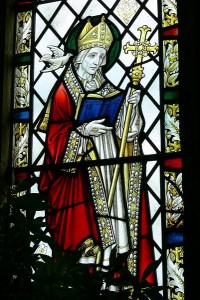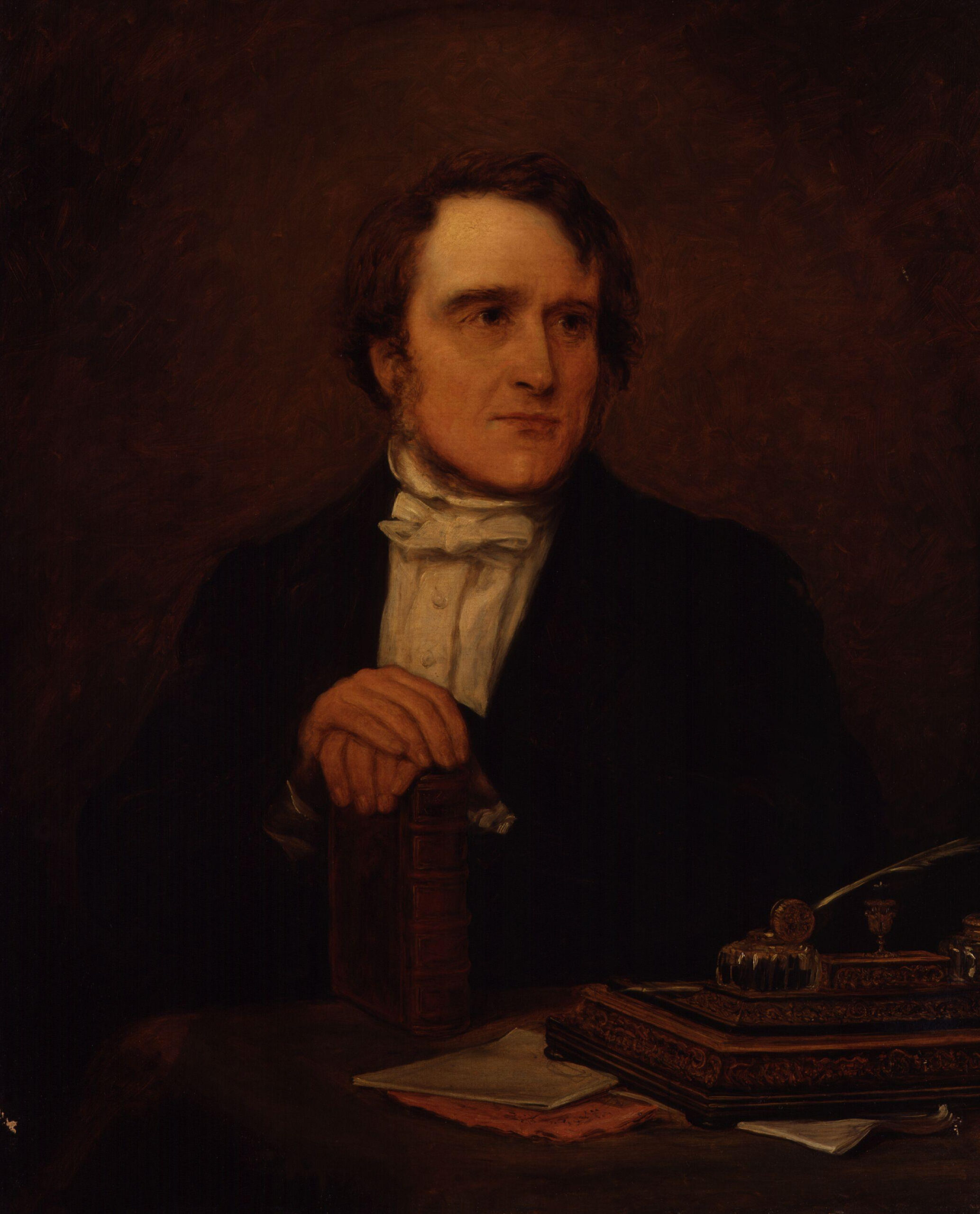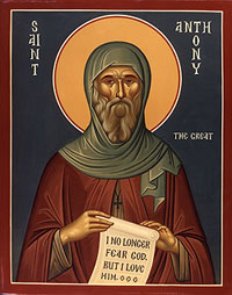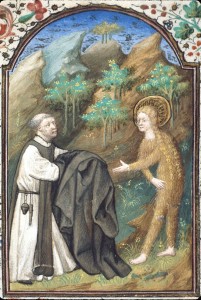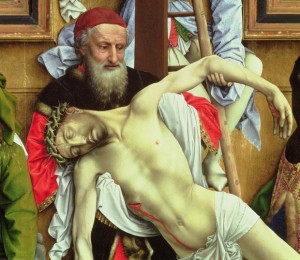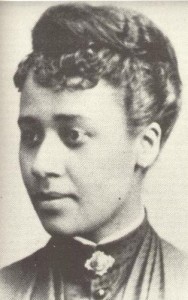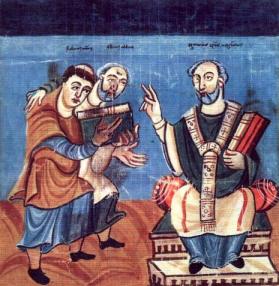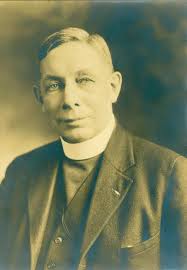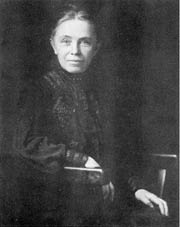The battleground is Great Britain as David of Wales goes up against F.D. Maurice of the Church of England. A bishop beloved by the Welsh vs. a social activist and theologian beloved by Anglo-Catholics. The winner advances to take on Julia Chester Emery.
In yesterday's match-up, a controversial pairing that brought together two ancient Egyptian ascetics, Antony of Egypt squeaked past Mary of Egypt 51% to 49%. People had a lot to say about this battle with a record number of comments recorded and if you thought your vote "didn't really matter," Antony prevailed by a mere 150 votes out of nearly 6,000 cast. He'll go on to face Basil the Great in the next round.
Speaking of voting, you should know that the Supreme Executive Committee keeps former President Jimmy Carter on retainer as an impartial election observer. This is just a reminder that Lent Madness suffrage entitles you to ONE vote per day. Big Brother (in the form of the technophile member of the SEC -- who used to work for IBM!) is watching. If you have more than one person (not including dog, cat, ferret, etc) in your household he/she/it can obviously also cast a vote on another device.
The elections so far have been clean but this is just a friendly reminder in light of yesterday's very close battle. So, your Christian duty this Lent is to vote. Just don't sin against God, the SEC, and the Lent Madness faithful and do it more than once.
The patron saint of Wales, David was a bishop of Menevia during the sixth century. Originally called to the monastic life, he ended up as a well-known church leader, teacher, and preacher. He founded numerous monasteries and churches throughout Wales and the surrounding areas. David also presided over two synods against Pelagianism (a heresy that denied the existence of original sin). The first synod was at Brefi around 560 and the second was at Caerleon (the “Synod of Victory”) around 569.
Legend has it that a miracle took place at the Synod of Brefi. While David was preaching a sermon in the village of Llanddewi Brefi, the place where he was standing rose up to form a hill, and a white dove landed on his shoulder. Commenters jest that the location of the miracle was already rather hilly, but the story is cherished as his best-known miracle. The white dove is seen as a symbol of his ministry. David is also associated with the leek, a symbol of Wales.
David lived a disciplined and ascetic life. His strict monasticism was modeled after the earliest Christian ascetics: hard manual labor without even the use of draught animals, silence, long hours of prayer, and a diet of bread and herbs without any meat and alcohol. No personal possessions were allowed.
Some accounts claim that David lived past the age of 100 years. His biographers described that the monastery was “filled with angels as Christ received his soul.” One biographer cited David’s last words to his community: “Be joyful, and keep your faith and your creed, and do the little things that you have seen me do and heard about. I will walk the path that our fathers have trod before us.” This entreaty is remembered as a well known Welsh saying: “Do ye the little things in life” (Gwnewch y pethau bychain mewn bywyd).
Through the leadership of David, many evangelists journeyed throughout the British Isles and Brittany, spreading the gospel.
Collect for David of Wales
Almighty God, you called your servant David to be a faithful and wise steward of your mysteries for the people of Wales: Mercifully grant that, following his purity of life and zeal for the Gospel of Christ, we may with him receive our heavenly reward; through Jesus Christ our Lord, who lives and reigns with you and the Holy Spirit, one God, for ever and ever. Amen.
Frederick Denison Maurice was born in 1805. He attended Trinity College, Cambridge, with the intention of becoming a barrister or lawyer. He was ultimately unable to receive his degree, because as a Unitarian and a dissenter from the established church, he refused to subscribe to the Thirty-Nine Articles of Religion, which defined the doctrine of the Church of England. Maurice moved to London, where he began to write in support of social reforms.
It was during his time in London that Maurice converted to Anglicanism. In 1830, he left London to study at Exeter College in Oxford. By 1834, he was ordained as a priest and four years later he wrote his seminal work The Kingdom of Christ, in which he held that the Church was a united body, transcending individual sects, denominations, and disputes. While Maurice’s work would ultimately be an early source of Anglican ecumenism, it also roused suspicion among more conservative wings of the church. In 1846, he became a professor of theology at Kings’ College, London.
European society changed rapidly in the first half of the nineteenth century, as advances in industrialization ultimately led to the rise of a new middle class, which created new social tensions. During the same year that socialist Karl Marx famously called religion “the opiate of the people,” Maurice wrote, “we have been dosing our people with religion…when what they want is...the living God.” Later, inspired by the Revolutions of 1848, a wave of political upheavals across Europe, Maurice became one of the organizers of the Christian Socialist Movement, seeking to, as he said, engage in the conflict with “unsocial Christians” and “unchristian Socialists.” The Christian socialists sought to apply Christian principles to laissez-faire industrialism, advocating for a collective responsibility for the poor and those in substandard factory working conditions.
Unlike Marx, the Christian Socialists would advocate for the active involvement of the Church in improving the lot of the working class. Maurice’s book Theological Essays, published in 1853, ultimately cost him his job as a professor when it was viewed as being heterodox—too much at odds with the established Church. Using his existing knowledge and teaching experience to improve the lives of the working class, he founded the Working Men’s College to promote his ideals. Ultimately he returned to the academy, teaching in Cambridge from 1866 until his death.
Collect for F. D. Maurice
Almighty God, who restored our human nature to heavenly glory through the perfect obedience of our Savior Jesus Christ: Keep alive in your Church, we pray, a passion for justice and truth; that, like your servant Frederick Denison Maurice, we may work and pray for the triumph of the kingdom of your Christ; who lives and reigns with you and the Holy Spirit, one God, now and for ever. Amen.
-- David Sibley
Vote!
[poll id="81"]

